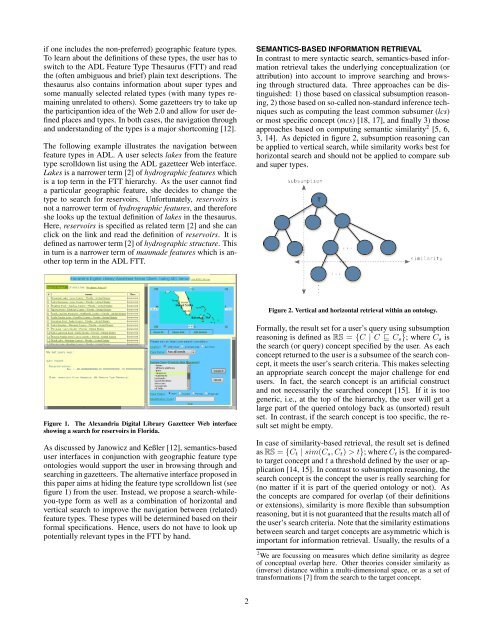Implementation and Evaluation of a Semantics-based User Interface ...
Implementation and Evaluation of a Semantics-based User Interface ...
Implementation and Evaluation of a Semantics-based User Interface ...
Create successful ePaper yourself
Turn your PDF publications into a flip-book with our unique Google optimized e-Paper software.
if one includes the non-preferred) geographic feature types.<br />
To learn about the definitions <strong>of</strong> these types, the user has to<br />
switch to the ADL Feature Type Thesaurus (FTT) <strong>and</strong> read<br />
the (<strong>of</strong>ten ambiguous <strong>and</strong> brief) plain text descriptions. The<br />
thesaurus also contains information about super types <strong>and</strong><br />
some manually selected related types (with many types remaining<br />
unrelated to others). Some gazetteers try to take up<br />
the participantion idea <strong>of</strong> the Web 2.0 <strong>and</strong> allow for user defined<br />
places <strong>and</strong> types. In both cases, the navigation through<br />
<strong>and</strong> underst<strong>and</strong>ing <strong>of</strong> the types is a major shortcoming [12].<br />
The following example illustrates the navigation between<br />
feature types in ADL. A user selects lakes from the feature<br />
type scrolldown list using the ADL gazetteer Web interface.<br />
Lakes is a narrower term [2] <strong>of</strong> hydrographic features which<br />
is a top term in the FTT hierarchy. As the user cannot find<br />
a particular geographic feature, she decides to change the<br />
type to search for reservoirs. Unfortunately, reservoirs is<br />
not a narrower term <strong>of</strong> hydrographic features, <strong>and</strong> therefore<br />
she looks up the textual definition <strong>of</strong> lakes in the thesaurus.<br />
Here, reservoirs is specified as related term [2] <strong>and</strong> she can<br />
click on the link <strong>and</strong> read the definition <strong>of</strong> reservoirs. It is<br />
defined as narrower term [2] <strong>of</strong> hydrographic structure. This<br />
in turn is a narrower term <strong>of</strong> manmade features which is another<br />
top term in the ADL FTT.<br />
SEMANTICS-BASED INFORMATION RETRIEVAL<br />
In contrast to mere syntactic search, semantics-<strong>based</strong> information<br />
retrieval takes the underlying conceptualization (or<br />
attribution) into account to improve searching <strong>and</strong> browsing<br />
through structured data. Three approaches can be distinguished:<br />
1) those <strong>based</strong> on classical subsumption reasoning,<br />
2) those <strong>based</strong> on so-called non-st<strong>and</strong>ard inference techniques<br />
such as computing the least common subsumer (lcs)<br />
or most specific concept (mcs) [18, 17], <strong>and</strong> finally 3) those<br />
approaches <strong>based</strong> on computing semantic similarity 2 [5, 6,<br />
3, 14]. As depicted in figure 2, subsumption reasoning can<br />
be applied to vertical search, while similarity works best for<br />
horizontal search <strong>and</strong> should not be applied to compare sub<br />
<strong>and</strong> super types.<br />
Figure 2. Vertical <strong>and</strong> horizontal retrieval within an ontology.<br />
Figure 1. The Alex<strong>and</strong>ria Digital Library Gazetteer Web interface<br />
showing a search for reservoirs in Florida.<br />
As discussed by Janowicz <strong>and</strong> Keßler [12], semantics-<strong>based</strong><br />
user interfaces in conjunction with geographic feature type<br />
ontologies would support the user in browsing through <strong>and</strong><br />
searching in gazetteers. The alternative interface proposed in<br />
this paper aims at hiding the feature type scrolldown list (see<br />
figure 1) from the user. Instead, we propose a search-whileyou-type<br />
form as well as a combination <strong>of</strong> horizontal <strong>and</strong><br />
vertical search to improve the navigation between (related)<br />
feature types. These types will be determined <strong>based</strong> on their<br />
formal specifications. Hence, users do not have to look up<br />
potentially relevant types in the FTT by h<strong>and</strong>.<br />
Formally, the result set for a user’s query using subsumption<br />
reasoning is defined as RS = {C | C ⊑ C s }; where C s is<br />
the search (or query) concept specified by the user. As each<br />
concept returned to the user is a subsumee <strong>of</strong> the search concept,<br />
it meets the user’s search criteria. This makes selecting<br />
an appropriate search concept the major challenge for end<br />
users. In fact, the search concept is an artificial construct<br />
<strong>and</strong> not necessarily the searched concept [15]. If it is too<br />
generic, i.e., at the top <strong>of</strong> the hierarchy, the user will get a<br />
large part <strong>of</strong> the queried ontology back as (unsorted) result<br />
set. In contrast, if the search concept is too specific, the result<br />
set might be empty.<br />
In case <strong>of</strong> similarity-<strong>based</strong> retrieval, the result set is defined<br />
as RS = {C t | sim(C s , C t ) > t}; where C t is the comparedto<br />
target concept <strong>and</strong> t a threshold defined by the user or application<br />
[14, 15]. In contrast to subsumption reasoning, the<br />
search concept is the concept the user is really searching for<br />
(no matter if it is part <strong>of</strong> the queried ontology or not). As<br />
the concepts are compared for overlap (<strong>of</strong> their definitions<br />
or extensions), similarity is more flexible than subsumption<br />
reasoning, but it is not guaranteed that the results match all <strong>of</strong><br />
the user’s search criteria. Note that the similarity estimations<br />
between search <strong>and</strong> target concepts are asymmetric which is<br />
important for information retrieval. Usually, the results <strong>of</strong> a<br />
2 We are focussing on measures which define similarity as degree<br />
<strong>of</strong> conceptual overlap here. Other theories consider similarity as<br />
(inverse) distance within a multi-dimensional space, or as a set <strong>of</strong><br />
transformations [7] from the search to the target concept.<br />
2

















